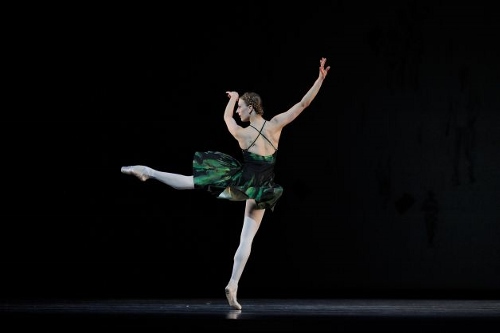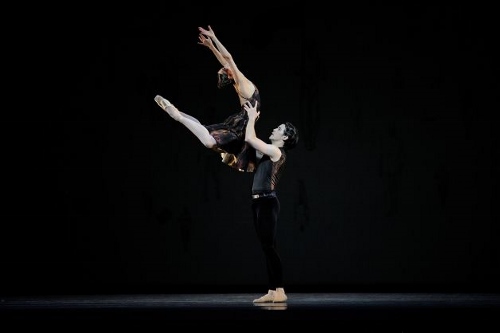|
 |
|
|
 |
 |
A co-production with American Ballet Theatre, Alexei Ratmansky's Shostakovich Trilogy was set to three works by Dmitri Shostakovich; an unusual and challenging choice for any choreographer. The story of the composer's life during various phases of the Soviet Union under Joseph Stalin provided Ratmansky with several choreographic motifs. Under the baton of conductor Martin West the first in the trilogy was Symphony #9, featuring five soloists and sixteen corps members. The music and the dancers moved briskly from one section to another with the men's variations dominating the work. There seemed to be three dimensions of men's solos: Luke Ingham, Pascal Molat and Hansuke Yamamoto each presented different aspects of what might be the composer's heroism, retreat, exaltations and despair. None of this was specific yet as in all three works, the corps seemed to assist the soloists. They lifted, carried, rolled and often surrounded then deserted them. The women soloists for Friday April 11 were listed as Mathilde Froustey and Lorena Feijoo. Next Shostakovich's "Chamber Symphony" was more detailed in its narrative elements yet it continued many of the themes found in the first part of the trilogy. A unique figure, danced by Jaime Garcia Castilla, confronted three women each in a unique manner. Apparently there were three women central to Shostakovich's life. Those roles were danced by Dores André, Simone Messmer and Sarah Van Patten. As Castilla interacted with each, the corps de ballet interrupted, separating the couple and ultimately removing the woman. The corps ultimately cast the main character aside as well. According to program notes, these phases represented Shostakovich's struggles to be accepted by his comrades and the leadership of the Soviet Union. Castilla was particularly effective in his role and made the interactions clear. Although Ratmansky says in program notes, that all the ballet is 'abstract,' these dramatic elements prevailed. The last in the trilogy, "Piano Concerto #1", was the liveliest and best danced. Notable were the outstanding performances by Joan Boada and Frances Chung. The other soloists, Sofiane Sylve and Tiit Helimets were fine, but for this reviewer, Chung and Boada were the stars. Chung has become a most resourceful ballerina; her footwork, nuanced body and arm movements coordinate beautifully with her partner's and the line of her dynamic patterns is a joy to behold. In general, "Piano Concerto #1" used the corps more effectively than in the other two sections and they were an excellent contrast to the four soloists. The music was performed by the pianist Michael McGraw and trumpeter John Pearson along with the orchestra under the baton of Martin West. Ratmansky has produced a triumphal evening of works, at least one of which will be retained in SF Ballet's repertory. All three were lively, albeit using many repetitive devises (male corps entering first, solo male figure, solo women figures, many stage crossings of leaps, turns and jumps), but these are usual in contemporary classical ballet. One longs for the return of classicism, some symmetry, repeated rhythms and clarity. We will have to wait for the SF Ballet's Program 8 featuring the works of George Balanchine for that.
 Simone Messmer in "Shostakovich Trilogy" Photo © & courtesy of Erik Tomasson |
|
 Sarah Van Patten and Carlos Quenedit in Symphony #9 from Ratmansky's "Shostakovich Trilogy" Photo © & courtesy of Erik Tomasson |
|
|
|



